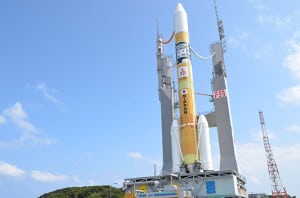Latest News
JAXA Chooses Mitsubishi Heavy Industries to Develop New Launcher With Greater Commercial Focus
[Via Satellite 03-25-2014] Approximately one month after beginning its search for a new prime contractor, the Japan Aerospace Exploration Agency (JAXA) selected Mitsubishi Heavy Industries (MHI) to develop the agency’s new flagship launch vehicle. MHI is tasked with leading a consortium of companies from the private sector and will be responsible for development and launch services. JAXA will be responsible for managing and integrating the overall development of the new flagship launch vehicle.
“When the proposal of the next generation launcher came out, it was expected that it would be awarded to Mitsubishi,” said Kazuto Suzuki, Ph.D., associate professor of international political economy at Hokkaido University in Japan. “It was a matter of time.”
Maintaining autonomous space launch capability is one of Japan’s space policy pillars, hence leading JAXA to select a domestic prime contractor. However, JAXA wants to create a rocket that will achieve a significant presence on the international scene as a major launch provider. According to Suzuki, this juxtaposition of public and private sector goals may be difficult to reach.
“If you want to give an opportunity for the engineers to do new research, it is going to be expensive and new, which would be seen as unreliable because it doesn’t have the experience or record of success,” said Suzuki. “I think these two objectives contradict each other, and therefore I think the chances of this new launcher attracting foreign customers is weak, particularly for the commercial market to GTO and GEO satellite operators.”
The full extent of MHI’s creative license is not yet known. According to JAXA’s press release, the new launcher will still be based on previous rockets. It will have a “more sophisticated” high performance liquid hydrogen rocket engine, and up to six solid rocket boosters that are based on technology from the Epsilon Launch Vehicle. JAXA states the new launch vehicle will be similar to that of the H2A — Japan’s current flagship launch vehicle — but is focused on leveraging updated technology to reduce costs and preserve Japan’s technological capability.
“I think the most probable customers are foreign government customers,” said Suzuki. “JAXA will use some political leverage to use a Japanese launcher for launching foreign satellites or which will be procured and operated by the foreign government … there are 20 to 30 launches per year for the commercial telecommunications market and there are too many launchers, so the challenges for [the next generation rocket] will be big if there is no financial support to improve the cost competitiveness. It’s going to be cheaper than the H2A for sure, but I don’t think the cost will be drastically reduced enough to compete with launchers like the Falcon 9.”
The H2A rocket is based on the H2 design, which is more than 30 years old. According to the agency, the cost of maintaining this rocket grows annually, and the engineers who were involved in the actual development are “graying.” Japan has not initiated a new launch vehicle development project for roughly 15 years. This update is just as much about sustaining access to space as it is entering the competitive market.
“If we left this situation unattended, Japan will face difficulty to maintain our development and launch capability of launch vehicles in the future,” the agency said in a press release. “Although our flagship launch vehicle technology is highly regarded, we need to lower the launch costs in order to procure commercial satellite launch demand from overseas in addition to our country’s government satellites.”
The H2 rocket was fully controlled by JAXA based on government interests. Its successor, the H2A, was intended to be more cost-effective, but did not reach the level of competitiveness the agency had desired. The new series will be both MHI built and MHI owned, giving the company much more freedom than was ever granted in the past.
“There is a gradual shift from JAXA-oriented to private-oriented,” explained Suzuki. “In the past, JAXA was the prime contractor, so to speak. JAXA had its own engineers to make designs, do the research and development, and everything. Mitsubishi was the subcontractor. Now Mitsubishi is taking on the lead, [and] JAXA has begun a more supervisory role. This is a shift from H2, H2A, H2B and now to this new launcher.”
The new flagship launch vehicle begins development in early Japan Fiscal Year 2014, with a maiden launch date planned tentatively for 2020. Seeing how international competitiveness was a goal for the H2A as well, it is yet to be determined whether or not the new launcher will gain traction in foreign markets. Beyond reaching Japan’s space policy goals, JAXA and MHI will have to work hard to make the new launcher reach its other objectives through an effective balance between the efficiency of new equipment and the heritage of older systems.
Get the latest Via Satellite news!
Subscribe Now